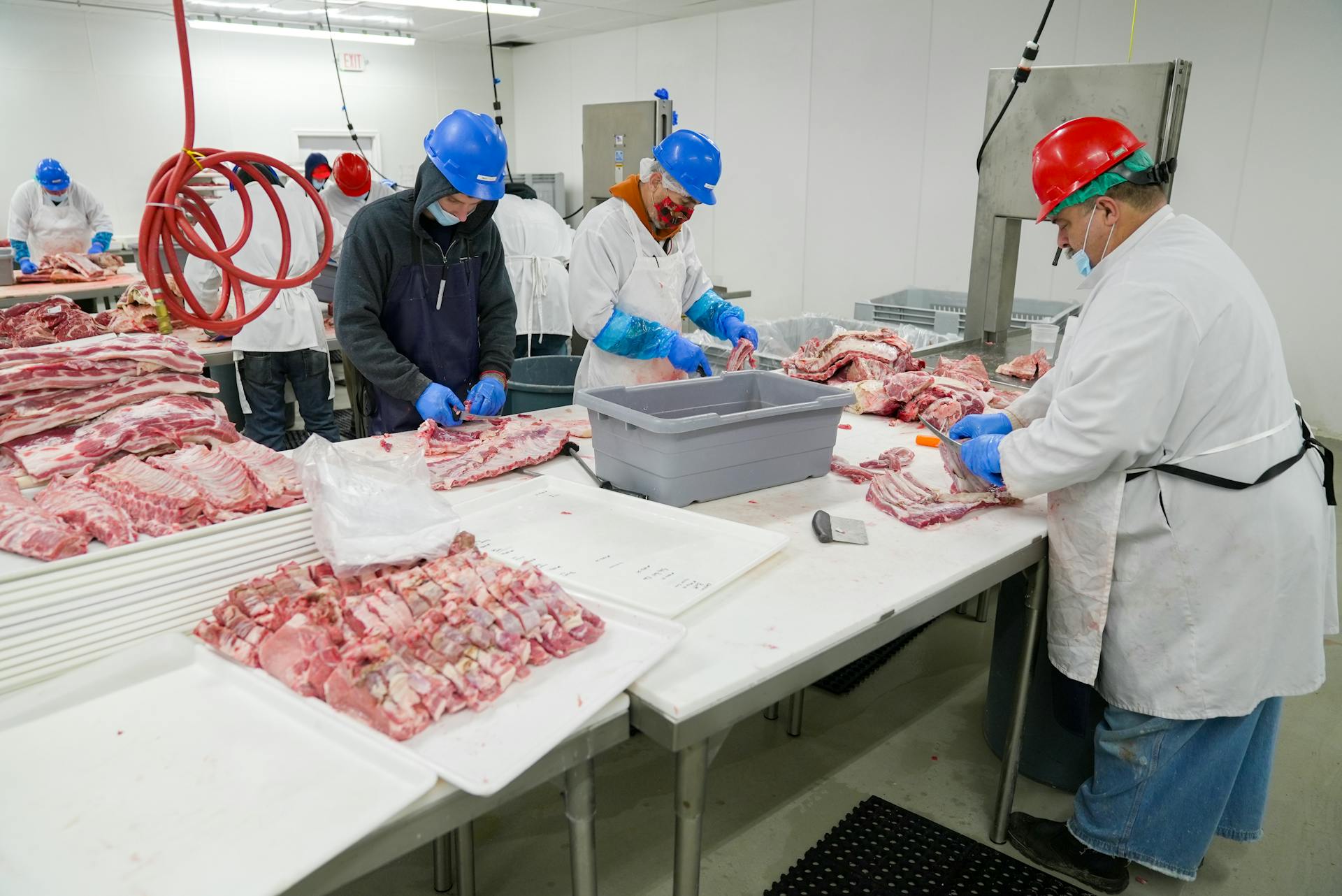
If you're considering purchasing a home in Alabama, you're likely aware of the state's unique housing market. To qualify for a USDA home loan in Alabama, you'll need to meet certain income and property requirements.
The USDA sets income limits for borrowers based on the area's median income. In Alabama, the income limits vary by county, but for a family of four, the limit is $90,300 or less in most areas.
To be eligible for a USDA home loan, you'll also need to ensure the property meets the USDA's location requirements. This means the property must be located in a rural area, which is defined as outside of a city or town with a population of 35,000 or more.
In Alabama, many rural areas qualify for USDA home loans, including parts of counties like Madison, Limestone, and Morgan.
Broaden your view: Reverse Mortgage Equity Requirements
USDA Home Loan Requirements in Alabama
The USDA home loan requirements in Alabama are pretty specific, but don't worry, I've got the lowdown. To qualify, the property you're looking to buy must be located in a rural area, which is defined by the USDA as having a population of 35,000 or less.
You can check if a property address qualifies by using the USDA's property eligibility map available on their website. Most of the immediate areas in major cities like Birmingham, Huntsville, Montgomery, and Mobile likely won't be eligible for USDA financing.
However, many of the outlying locations are still approved, so it's worth exploring those options. If you're planning to purchase a home in one of the major cities, there are other down payment assistance programs available that you can look into.
The USDA defines rural areas as regions with a population of 35,000 or less, which is why the USDA Alabama eligibility map is a great resource to determine if a property qualifies.
Consider reading: Usda Mortgage Map Pa
Eligibility and Qualification
To qualify for a USDA home loan in Alabama, you'll need to meet certain eligibility requirements. Your household income cannot exceed 115% of the median income in the county where your new house is located.
You must be a U.S. citizen or permanent resident, with a proven history of dependable income. A credit history that demonstrates a reliable ability to repay debts is also necessary, with a score of at least 640 to qualify for streamlined processing.
Curious to learn more? Check out: Using Rental Income to Qualify for Conventional Mortgage
To determine your income eligibility, consult the USDA map and table, which provides income limits by county and household size.
Here are the key income eligibility requirements:
- Household income must be 115% or less of the median income in the county where your new house is located
- You must have a stable income and be able to afford mortgage payments without incident for at least one year based on your savings, current income, and total assets
- Your debt-to-income ratio should be 50% or lower
Additionally, lenders will assess your employment history and income stability to ensure you have a reliable source of income to repay the loan. A stable employment history of at least two years is preferred, but standard gaps in employment are permitted with explanation.
To get pre-qualified for a USDA loan, you'll need to provide general information to a mortgage lender, including details about your income, assets, debts, and expenses. This will help determine the loan amount you can afford and your potential approval eligibility.
For your interest: Will Lender Accept If a Friend Gift Money Conventional Loan
Program Details
In the USDA home loan program, there's no down payment required, which means you can finance 100% of the home's purchase price. This is made possible by the lender taking on the risk of the loan, which is safeguarded by a mortgage insurance fee.
The upfront mortgage insurance fee is 1% of the total outstanding loan, and this amount can be added to the loan and financed over time. This fee is a guarantee fee charged by the USDA to protect the lender.
USDA loans also have a yearly mortgage insurance fee of 0.35% of the loan's outstanding balance, which is divided by 12 and added to the monthly payment made by the borrower.
You can expect competitive 30-year fixed interest rates with USDA loans, and there's no maximum loan amount. This means you can borrow as much as you need to purchase a home, as long as it's within your budget.
Here are the details of the upfront and yearly mortgage insurance fees:
These fees are in addition to the interest on your loan, so be sure to factor them into your budget when considering a USDA home loan.
Benefits and Advantages
The USDA home loan is a fantastic option for many homebuyers, especially first-timers. It offers several benefits and advantages that make it an attractive choice.
No down payment is required, which can be a huge obstacle for many buyers. This means you can borrow up to the home's appraised value without needing to save for a down payment.
USDA loans also offer lower interest rates compared to conventional loans. This can save you money on your monthly mortgage payments.
Flexible credit requirements make it easier for borrowers with lower credit scores or less-than-perfect credit history to qualify. A good credit history can improve your chances of approval, but it's not the only factor considered.
Low mortgage insurance costs are another benefit of USDA loans. The upfront fee is just 1% of the loan amount, and the annual fee is only 0.35%. This is lower than many other mortgage financing programs.
Here are some key benefits of USDA loans at a glance:
- Zero Down Payment: No down payment required, making homeownership more accessible.
- Competitive Interest Rates: Lower interest rates compared to conventional loans.
- Flexible Credit Requirements: Easier to qualify with lower credit scores or less-than-perfect credit history.
- Low Mortgage Insurance: Lower upfront and annual mortgage insurance costs.
The USDA loan is a 30-year fixed rate loan, with low and affordable monthly payments. This makes it a great option for many homebuyers.
Application and Approval
Applying for a USDA loan in Alabama can be a straightforward process if you follow the right steps. The first step is to check your eligibility, which involves meeting specific income and credit requirements.
To apply for a USDA loan, you'll need to gather required documents, including proof of income, employment, and credit history. Applying for a USDA loan involves several steps, and understanding the process can help you prepare and avoid any potential delays.
You'll need to submit your application through a lender or mortgage broker who is authorized to originate USDA loans. Applying for a USDA loan in Alabama can be a great option for those looking to purchase a home in a rural area.
The lender will review your application and credit report to determine your creditworthiness and ability to repay the loan. It's essential to work with a lender who has experience with USDA loans to ensure a smooth application process.
Once your application is approved, you'll need to complete a home inspection and appraisal to ensure the property meets USDA loan requirements.
Recommended read: Does the Housing Industry Need More Correspondent Lending
Property and Location
To be eligible for a USDA loan, your home must be located in an eligible rural or suburban area. The USDA loan property requirements are available on the department's website, and you'll need the home's address to determine if it qualifies.
The property must be located in an area that is marked "rural" by the USDA, but surprisingly, most potential homes will be eligible for the program. In fact, our loan officers have access to the most recent USDA maps and can answer questions about any prospective home's eligibility.
USDA loans are only available for properties located in eligible rural areas, and you can check if a property address qualifies by using the USDA's property eligibility map available on their website.
Consider reading: Usda Rural Home Loan Oregon
Eligible Property Types
To find an eligible property, you can work with a real estate agent familiar with USDA loans. They can help you find properties in Alabama.
Single-family homes, condominiums, and approved manufactured homes are all types of properties that can be purchased with a USDA loan. The property must be located in an eligible rural area.
The USDA's online tools can be used to check property and income eligibility. This is a crucial step before starting the application process.
You can use a USDA loan to purchase a single-family home, a condo, or an approved manufactured home.
Recommended read: What Is a Balloon Payment Loan
Rural Area
A rural area is defined as a region with a population of 35,000 or less. This is a crucial factor in determining if a property is eligible for a USDA loan.
To find out if a property is located in a rural area, you can use the USDA's online tools, such as their property eligibility map. This map is available on their website and can help you determine if a property meets the USDA's definition of rural.
The USDA's definition of rural includes areas outside of cities and towns, where the population is below 35,000. However, even if an area was once considered rural but lost that designation after the 1990, 2000, or 2010 census, it may still be eligible if its population doesn't exceed 35,000 and lacks mortgage credit for low- or moderate-income families.
It's worth noting that many places aside from cities or metropolitan regions fit within these guidelines, so it's worth exploring these areas if you're looking for a rural property.
Curious to learn more? Check out: Usda Home Loan Map California
Financing and Insurance
USDA loans don't require private mortgage insurance, unlike conventional mortgage loans, which often include it if you have less than 20% equity in your home.
The annual premium for a USDA loan is significantly lower than the monthly mortgage insurance fees for conventional loans.
A USDA loan comes with a guarantee fee, but it's a relatively low 1% and can even be financed into the loan.
A fresh viewpoint: A Conventional Mortgage Usually Has
Closing Costs
Closing costs can be a significant chunk of change, totaling up to thousands of dollars. These costs are associated with every type of loan, including USDA loans.
Some examples of closing costs include title insurance, recording fees, and escrow closing fees. You'll also need to factor in homeowner's insurance and a survey, if required. An appraisal may also be necessary, unless it's paid upfront.
The good news is that the seller can pay some or all of the closing costs, or you can receive a gift to cover them. The USDA program allows three options for paying closing costs: you can pay them at closing, receive a gift, or have the seller cover them.
For your interest: Mortgage Fha Rates Closing Costs Refinance
Here are the three options for paying closing costs in more detail:
- The buyer may pay them at the time the loan is closed
- The buyer may receive a gift to cover the closing costs, accompanied by a letter explaining the gift and the nature of the relationship between the buyer and the giver of the gift
- The seller may pay part or all of the closing costs, but there are limits to what can be paid
If you're planning to negotiate with the seller to pay the closing costs, it's a good idea to speak with a loan officer who's experienced with the USDA program to understand the limits.
Best Mortgage Rates
To get the best mortgage rates, it's essential to have your financials in order. This means pulling your credit reports from Experian, Equifax, and TransUnion and addressing any errors you find.
Paying down larger balances will not only improve your credit score but also reduce your debt-to-income ratio. A better credit score and lower DTI can net you a better rate on a USDA loan.
Making a down payment on a USDA loan, even if it's zero, will make you look like a safer candidate to lenders. This can result in lower rate offers.
Comparing mortgage rates between at least three USDA lenders is crucial. Even small differences in the rate you pay can save you thousands of dollars over the term of a home loan.
Check this out: Do Credit Unions Have Better Mortgage Rates
If you're a first-time homebuyer, look into state housing authority programs that offer down payment and closing cost assistance in the form of grants. These nonprofit agencies can help make homeownership more affordable.
USDA loans have geographic and price limitations, so it's essential to consider alternative loan options like FHA loans or proprietary loan programs from lenders that specialize in working with low-income borrowers.
Private Mortgage Insurance
Private Mortgage Insurance is not a requirement for USDA loans, which is a nice break from the typical mortgage rules.
Unlike conventional loans, USDA loans don't have private mortgage insurance unless the borrower has less than 20% equity in their home.
The annual premium for a USDA loan is significantly lower, coming in at two times lower than monthly mortgage insurance fees for conventional loans.
A USDA loan also includes a guarantee fee, which is a relatively low 1% of the loan amount.
For your interest: Lowers Mortgage Rates
Frequently Asked Questions
What disqualifies you from a USDA loan?
USDA loans are disqualified for properties with major structural issues, safety hazards, or other concerns that make the home uninhabitable
Sources
- https://www.nerdwallet.com/article/mortgages/usda-loan
- https://www.madisonmortgageguys.com/programs/government/usda-rural-housing/
- https://www.primelending.com/purchase/usda-mortgage
- https://cishomeloans.com/blog/usda-home-loan-process/
- https://coast2coastlending.com/usda-mortgage-approval-process-for-alabama/
Featured Images: pexels.com


